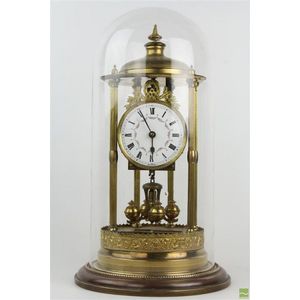Rare 19th Century Franche-Comte Carriage Clock by Jn Marc Michoudet
You must be a subscriber, and be logged in to view price and dealer details.
Subscribe Now to view actual auction price for this item
When you subscribe, you have the option of setting the currency in which to display prices to $Au, $US, $NZ or Stg.
- Movement - The technical name for the workings of a clock or watch, and does not include the dial or case.
- Grande Sonnerie - A grande sonnerie is a striking system in a clock which strikes each quarter hour, striking one, two three or four times, followed by striking the hour on a different toned bell. The preceding hour may also be struck as each quarter hour.
- Circa - A Latin term meaning 'about', often used in the antique trade to give an approximate date for the piece, usually considered to be five years on either side of the circa year. Thus, circa 1900 means the piece was made about 1900, probably between 1895 and 1905. The expression is sometimes abbreviated to c.1900.
- Barrel (in a Clock) - In a clock or watch, the barrel is a cylindrical component that stores the energy from the mainspring. As the mainspring is wound, it stores energy in the barrel. As the clock or watch runs, the energy is gradually released from the barrel, turning the clock's gears and keeping the time.
The barrel is typically located near the centre of the movement (the mechanism that powers the clock) and is connected to the center wheel, which drives the rest of the gears. The barrel typically has teeth on its outer surface that mesh with the gears in the movement, allowing it to transmit energy to the rest of the clock. Some barrels are designed to be wound by hand, while others are automatically wound by the motion of the wearer's arm.
This item has been included into following indexes:
- clocks, carriage
Visually similar items

German made brass in dome clock vintage German made glass domed anniversary clock with rotating pendulum. This handsome polished brass clock features a number of vintage elements such as seven point crown to the top of the clock face, enamed dial and balls

A Royal Worcester two handled vase, Harry Davis, circa 1924, ovoid, painted with Norfolk sheep, signed by the artist, with two C scroll handles, seated on a pedestal foot, puce factory mark to base, model no. 1951, 31 cm high

An 1892 half sovereign, fair condition, wt. 3.96g

A Victorian sterling silver cruet, 1846 London, with maker's marks for Samuel Whitford II or Samuel Wheatley, the five bottle cruet with a shaped carry handle and supported on three curvaceous legs with shell pad feet, with an applied rocaille cartouche wi
